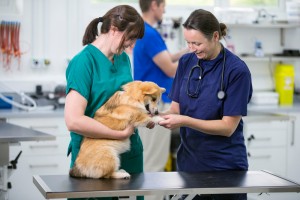New Study Compares Health Effects of Spay, Castration, Vasectomy and Ovary-Sparing Spay in Dogs
 Gonadectomy is the most common surgery performed on dogs in the United States, with about 64% of all dogs gonadectomized. This surgery involves removing the gonads; that is, the testicles in males and ovaries (and uterus) in females.
Gonadectomy is the most common surgery performed on dogs in the United States, with about 64% of all dogs gonadectomized. This surgery involves removing the gonads; that is, the testicles in males and ovaries (and uterus) in females.
For many years dog owners and veterinarians believed gonadectomy of dogs increased a dog’s odds of a long life with good health. But more recent evidence has suggested that health effects—good or bad—may depend on the breed or size of dog and the age at which it underwent gonadectomy.
On the plus side, gonadectomy is credited with reduced chance of testicular tumors, benign prostatic hyperplasia and perianal adenomas in males, and ovarian tumors, pyometra and (controversially) mammary cancer in females. Gonadectomy has traditionally been thought to reduce urine marking, aggression, mounting and roaming but more recent studies have reported conflicting data on aggression and gonadectomy.
On the minus side, gonadectomized dogs have an increased risk of obesity, and of orthopedic disorders such as cranial cruciate ligament rupture, hip dysplasia and patellar luxation, and possibly autoimmune disorders, vaccine reactions, hypothyroidism, pancreatitis and cognitive impairment. Gonadectomy has also been associated with increased risk of some cancers, such as hemangiosarcoma, lymphoma, mast cell tumors, transitional cell carcinoma of the bladder, and osteosarcoma.
In light of these concerns some veterinarians now offer alternative sterilization surgeries that preserve the gonads and the hormones they release. These surgeries are vasectomy (VS) for males and ovary-sparing spay (OSS) for females. In a VS surgery, the vas deferens is cut and sealed. In an OSS surgery, the uterus only is removed.
In a new study published in JAVMA, researchers led by Chris Zink, DVM, PhD, DACVSMR, compared owner-reported health and behavior from intact, gonadectomized, and VS or OSS dogs. They compared surveys for more than 6000 dogs, which included 1,056 sexually intact, 1,672 castrated and 58 VS males and 792 sexually intact, 2,281 spayed, and 159 OSS females.
Here’s what they found:
- Neutered males and spayed females had more orthopedic problems than intact males, intact females or OSS females.
- Intact males were less likely to have any type of cancer compared to neutered males. However, gonadectomized dogs had a later age of cancer diagnosis than intact dogs. But the longer the gonads were present, the later the age of cancer diagnosis.
- Intact males and females were less likely to be obese than neutered or spayed dogs. Intact males were less likely to be obese than OSS females.
- Intact females were less likely to have an endocrine condition compared to intact males, neutered males and spayed females.
- Neutered males were less likely to have a reproductive-related problem compared to intact males, intact females, spayed females or OSS females. The longer the gonads were present, the more likely a reproductive-related problem.
- Spayed females were overall more likely to have a health problem compared to intact males, intact females and neutered males.
- Neutered males were more likely to have a behavioral problem than intact males, intact females, spayed females or OSS females.
- Intact females and spayed females were less likely to have nuisance behaviors compared to intact males, VS males and OSS females. Male dogs of all reproductive groups, as well as OSS females were more likely to mark or mount than intact or spayed females. There was no difference in marking or mounting between neutered and intact males.
- Intact males and females had a higher chance of a shorter lifespan due to hazards. No other differences in lifespan between reproductive groups were significant.
Overall, the longer gonads were present, the fewer general health and behavior problems, and the longer the lifespan. This suggests that even though few significant differences were seen between gonadectomized dogs versus VS males or OSS females, the fact that these gonad-sparing surgeries allow dogs to continue to receive benefits from their gonads suggests that the latter surgeries should have positive health benefits. The researchers suggest that the low numbers of such dogs in their study may have obscured these results.
The authors conclude: “Given the relatively low risk of these alternative surgeries, particularly in the hands of experienced veterinary practitioners, veterinarians might consider offering these alternative reproductive surgeries to allow dogs to obtain these benefits without experiencing unintentional reproduction.”
Zink, C., Delgado, M. M., & Stella, J. L. (2023). Vasectomy and ovary-sparing spay in dogs: comparison of health and behavior outcomes with gonadectomized and sexually intact dogs, Journal of the American Veterinary Medical Association (published online ahead of print 2023). https://avmajournals.avma.org/view/journals/javma/aop/javma.22.08.0382/javma
Short URL: http://caninechronicle.com/?p=258845
Comments are closed












